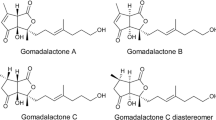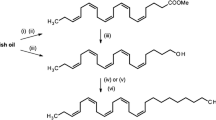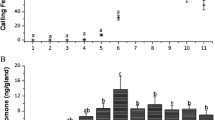Abstract
A bioassay based on male copulatory responses occurring on contact with dead decoy insects was used to confirm the existence of a sex pheromone in the screwworm fly,Cochliomyia hominivorax. Males responded to female but not male decoys. Mated and virgin females were equally stimulatory. Activity was abolished when females were washed with hexane but partially restored by treatment with crude hexane extract of females. Responses decreased when extracts were diluted and when the number of females extracted per milliliter of hexane was decreased from 20 to 1 in the preparation of extracts concentrated to 0.4 female/μl. Sexually mature female decoys of the 009 strain, the most laboratory-adapted of three strains examined in intrastrain tests, produced few copulatory attempts compared with those of Aricruz or DE-9 strains. However, newly emerged 009 as well as Aricruz females elicited responses from about 80% of sexually mature males. Those of the DE-9 strain stimulated fewer than 1%. The observation that 009 females were maximally stimulatory before becoming receptive to mating suggests that these strain differences resulted from laboratory colonization.
Similar content being viewed by others
References
Adams, T.S. 1979. The reproductive physiology of the screwworm,Cochliomyia hominivorax (Diptera: Calliphoridae) III. Mating.J. Med. Entomol. 15:488–493.
Antony, C., andJallon, J. 1982. The chemical basis for sex recognition inDrosophila melanogaster.J. Insect Physiol. 28:873–880.
Broce, A.B. 1980. Sexual behavior of screwworm flies stimulated by swormlure-2.Ann. Entomol. Soc. Am. 73:386–389.
Bushland, R.C. 1960. Screw-worm research and eradication.Adv. Vet. Sci. 6:1–18.
Carlson, D.A., Nelson, D.R., Langley, P.A., Coates, T.W., Davis, T.L., andLeegwater-Van Der Linden, M.E. 1984. Contact sex pheromone in the tsetse fly,Glossina pallidipes (Austen): Identification and synthesis.J. Chem. Ecol. 10:429–450.
Coates, T.W., andLangley, P.A. 1982. The causes of mating abstention in male tsetse flies,Glossina morsitans.Physiol. Entomol. 7:235–242.
Crystal, M.M. 1971. Diel periodicity of mating in laboratory-adapted screwworm flies relative to photoperiod.J. Med. Entomol. 8:747–748.
Crystal, M.M., andRamirez, R. 1975. Screwworm flies for sterile-male release: Laboratory tests of the quality of candidate strains.J. Med. Entomol. 12:418–422.
Crystal, M.M., andWhitten, C.J. 1976. Screwworm flies for sterile-male releases: Laboratory observations of the quality of newer candidate strains.Ann. Entomol. Soc. Am. 69:621–624.
Guillot, F.S., Brown, H.E., andBroce, A.B. 1978. Behavior of sexually active male screwworm flies.Ann. Entomol. Soc. Am. 71:199–201.
Hammack, L. 1984. Relationships of larval rearing variables to fly attraction and oviposition responses in the screwworm,Cochliomyia hominivorax (Diptera: Calliphoridae).J. Med. Entomol. 21:351–356.
Howard, R.W., andBlomquist, G.J. 1982. Chemical ecology and biochemistry of insect hydrocarbons.Annu. Rev. Entomol. 27:149–172.
Krafsur, E.S. 1978. Aggregations of male screwworm flies,Cochliomyia hominivorax (Coquerel) in South Texas (Diptera: Calliphoridae).Proc. Entomol. Soc. Wash. 80:164–170.
Langley, P.A., Pimley, R.W., andCarlson, D.A. 1975. Sex recognition pheromone in tsetse flyGlossina morsitans.Nature 254:51–53.
Mackley, J.W., andBroce, A.B. 1981. Evidence of a female sex recognition pheromone in the screwworm fly.Environ. Entomol. 10:406–408.
Mackley, J.W., andLong, G.L. 1983. Behavior of sterile adult screwworms (Diptera: Calliphoridae) on flowering trees and shrubs.Ann. Entomol. Soc. Am. 76:839–843.
Pomonis, J.G., andMackley, J. 1985. Gas chromatographic composition profiles of surface lipid extracts from screwworm compared by age, sex, colonization and geography.Southwest. Entomol. 10:65–76.
Richardson, R.H., Ellison, J.R., andAverhoff, W.W. 1982. Autocidal control of screwworms in North America.Science 215:361–370.
Rogoff, W.M., Beltz, A.D., Johnsen, J.O., andPlapp, F.W. 1964. A sex pheromone in the house fly,Musca domestica L.J. Insect Physiol. 10:239–246.
Steel, R.G.D., andTorrie, J.H. 1960. Principles and Procedures of Statistics. McGraw-Hill, New York, 481 pp.
Uebel, E.C., Sonnet, P.E., Miller, R.W., andBeroza, M. 1975. Sex pheromone of the face fly,Musca autumnalis De Geer (Diptera: Muscidae).J. Chem. Ecol. 1:195–202.
Author information
Authors and Affiliations
Rights and permissions
About this article
Cite this article
Hammack, L. Pheromone-mediated copulatory responses of the screwworm fly,Cochliomyia hominivorax . J Chem Ecol 12, 1623–1631 (1986). https://doi.org/10.1007/BF01020268
Received:
Accepted:
Issue Date:
DOI: https://doi.org/10.1007/BF01020268




